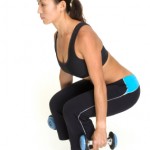
The squat is the king of lower body exercises, primed to firm the thighs and lift the cut of the glutes. If there is one exercise that will make you look great in those skinny jeans, or make your legs look slender in heels – it’s squats. But unfortunately there are so many myths and misconceptions about that squat that most people do not perform them anymore, or if they do squat they do it leaning into a Swiss ball that is against a wall or on a Smith machine, scared not to let the knees go forward of the toes as that is bad for the knees – what a load of BS!
Here are the most common myths about the squat:
• The knees shouldn’t go forward of the toes
• The thighs shouldn’t go below parallel
• The smith machine squat is safer than the free squat
• Swiss ball squats are safer then free squats
This is all nonsense. There is very little research to show squats are bad for the knees. This myth came about from a flawed and biased study conducted by Dr Karl Klein in 1961. Contrary to this, other studies have disproved Dr Klein’s findings. For instance, other researchers have found that both the deep squat (where the knees go forward of the toes and the thighs go below parallel) were not detrimental to knee stability; that basketball players and distance runners (who didn’t squat properly) had poorer knee stability compared to power lifters (who perform the deep squat often). Most importantly some research has shown that there was no knee instability found in athletes who used the squat exercise at 130%-200% of body weight twice a week as a part of their off-season training program. Clearly performing the squat, in its true form of bending the knees into the deep position, where the thighs go below parallel and the knees are forward over the toes is not detrimental to knee health. Not only this, but the full squat improves strength through range of movement giving you firm tighter legs. Dr Mark Rippetoe explains that the squat is an excellent exercise for development of the quads, hamstrings, glutes and low back. The deep squat best accomplishes this and encourages co-activation of the quads, hamstring and adductors to stabilise the knee, but also to firm up those muscles to make you look great in skinny jeans.
In fact performing the bastardised version of the squat with a Swiss ball or in a smith machine or just squatting to above parallel is actually bad for the knees and will not make you look as good in those skinny jeans. The half squat shortens the piriformis, a muscle deep in the buttocks that can squash the sciatic nerve and cause sciatica. In the half squat the ligaments that stabilise the knee are lax, whereas they are taught in the full squat, thus the half squat destabilises the knee. The half squat encourages strong quads but weak hamstrings which can be devastating for your cruciate ligaments (if you ski and don’t want to blow your cruciates – don’t do half squats with a Swiss ball or on a Smith machine). Plus much heavier loads are often used in the half squat that can overload the spine.
Caution
You should not squat if you have poor technique, are too weak or have poor flexibility to descend into the bottom position of the full squat. You may need to hire a trainer (who knows what he/she is talking about) to show you how to squat properly. Many other exercises can be used instead to build up strength and flexibility to prepare you for the squat. Read my article “Train your legs to lift your butt and tone your thighs” to learn how to use unilateral leg exercises to firm and tone your legs and prepare yourself for the squat.
Caution should also be taken as the squat:
• Loads the patella femoral joint
• Loads the posterior cruciate ligament between 30-90 degrees
• May not be indicated for those with osteoarthristis or osteochondral deficit
So squatting may not be the best exercise of choice if you have a patella femoral joint injury, if you are recovering in the acute stages of a PCL injury or if you have severe osteoarthristis or osteochondral deficit. However if you work with a strength coach or personal trainer who knows what they are doing they will be able to rehabilitate your knees so you can squat safely once again.
So unless you are one of the rare but unlucky few who should squat with caution here is a great leg routine including squats that is great for weight loss and for firming up the thigh and bum.
Routine
A1. Back squats 6 reps
A2. Walking lunges 12 reps (per leg)
A3. DB squats 25 reps
Rest 2 minutes and repeat. Do 3-4 circuits then curse me for the amount of burn in your bum and thighs and for having sore legs for the next 2 days.

